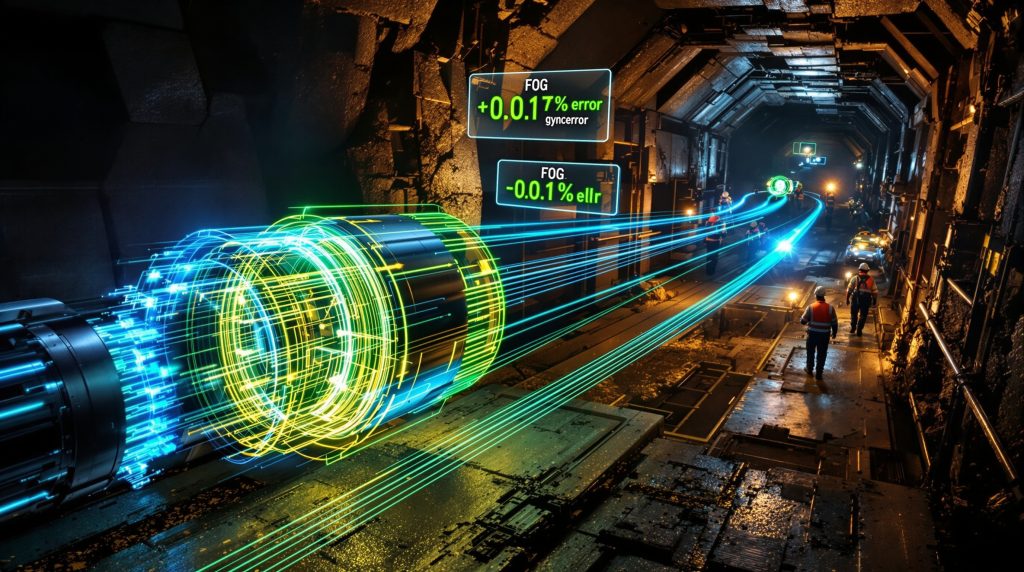Why Underground Mining Operations Require Advanced Navigation Solutions
Underground mining environments present unique navigation challenges that conventional GPS technology cannot address. Mining operations extending hundreds of meters below the earth's surface operate in what engineers classify as GNSS-denied zones, where satellite signals cannot penetrate effectively through rock formations and geological barriers. The implementation of fiber-optic gyroscope for underground mining has become crucial for maintaining operational efficiency in these challenging environments.
Traditional surface-based navigation systems fail in these environments due to signal attenuation from mineral deposits, electromagnetic interference from mining equipment, and the physical obstruction of satellite communications by overlying rock strata. These conditions create operational hazards including equipment collisions, inefficient routing, and personnel safety risks.
The Challenge of GNSS-Denied Environments
Underground mining operations face complete isolation from global navigation satellite systems once equipment descends beyond approximately 100-200 meters depth, depending on geological composition and tunnel configuration. This isolation forces mining operations to rely on alternative positioning technologies that can function independently of external signal sources.
The absence of reliable positioning data creates significant operational challenges including fleet coordination difficulties, resource allocation inefficiencies, and increased accident potential. Mining vehicles operating without precise navigation data experience reduced productivity due to suboptimal routing and increased maintenance requirements from equipment conflicts.
Safety and Operational Requirements
Underground mining safety regulations require continuous monitoring of personnel and equipment locations for emergency response coordination. The Mine Safety and Health Administration emphasises the critical importance of maintaining situational awareness in underground environments where traditional communication and navigation systems become unreliable.
Fleet management systems in underground operations must track vehicle positions, monitor loading cycles, and optimise transport routes to maximise productivity while maintaining safety protocols. Without accurate positioning data, these systems cannot provide the real-time decision support necessary for efficient underground operations.
How Fiber-Optic Gyroscopes Enable Underground Navigation
Fiber-optic gyroscope technology represents a revolutionary approach to underground navigation through the application of optical physics principles. These systems utilise the Sagnac effect, which measures rotational motion by detecting phase differences in light travelling through coiled optical fibres in opposite directions.
When a fiber-optic gyroscope for underground mining experiences rotation, counter-propagating light beams within the optical fibre coil experience different path lengths, creating measurable phase shifts proportional to the angular velocity. This optical measurement principle enables precise motion detection without reliance on external reference points or satellite signals.
Fundamental Technology Principles
The Sagnac effect forms the foundation of fiber-optic gyroscope operation, utilising the relationship between rotational motion and optical path differences. Light travelling in the same direction as rotation experiences a longer optical path, while light travelling opposite to rotation experiences a shorter path, creating detectable interference patterns.
Modern fiber-optic gyroscopes incorporate kilometres of optical fibre wound into precise coils, with laser light sources providing coherent illumination for accurate phase measurement. Advanced signal processing algorithms interpret these optical signals to calculate precise angular velocity measurements across three axes of rotation.
Performance Characteristics and Accuracy
Contemporary fiber-optic gyroscope systems achieve remarkable precision levels suitable for demanding navigation applications. Advanced inertial navigation systems demonstrate angular random walk specifications of less than 0.01 degrees per square root hour, providing navigation accuracy that maintains positional precision over extended operational periods.
These performance characteristics enable underground navigation solutions that can maintain positional accuracy within several metres over distances of multiple kilometres, representing significant improvements over traditional mechanical gyroscope systems that suffer from drift accumulation and mechanical wear.
| Technology Type | Accuracy Specification | Environmental Resistance | Mechanical Components |
|---|---|---|---|
| Fiber-Optic Gyroscope | 0.01°/√hr drift | Exceptional | None |
| Mechanical Gyroscope | 1-10°/hr drift | Moderate | Multiple |
| Magnetic Compass | Variable accuracy | Poor in ferrous environments | None |
Applications Driving Fiber-Optic Gyroscope Adoption in Mining
Underground haulage operations represent the primary application driving fiber-optic gyroscope adoption in mining environments. These systems provide continuous position, heading, and orientation data essential for fleet management coordination and route optimisation in complex underground networks.
Furthermore, industry innovation trends demonstrate that Advanced Navigation's 50 Series solutions showcase applications including underground haulage fleet management, downhole sensing and measurement, and rail-asset monitoring capabilities specifically designed for GNSS-denied mining environments.
Fleet Management System Integration
Underground fleet management systems require continuous vehicle tracking capabilities to optimise material transport cycles and prevent equipment conflicts in narrow tunnel environments. Fiber-optic gyroscope technology provides the positioning accuracy necessary for automated route planning and real-time fleet coordination.
Integration with existing fleet management software enables supervisors to monitor vehicle locations, track loading and dumping cycles, and identify operational bottlenecks that reduce mining productivity. This technological integration supports data-driven mining operations by overcoming operational blind spots and optimising resource utilisation throughout underground mining networks.
Measurement While Drilling Applications
Directional drilling operations in underground mining utilise fiber-optic gyroscope technology for precise drill head orientation monitoring during hole advancement. These applications require continuous angular measurement capabilities that maintain accuracy despite shock, vibration, and magnetic interference from surrounding ore bodies.
Downhole measurement systems incorporating fiber-optic gyroscopes enable drilling engineers to maintain precise hole trajectories for resource extraction optimisation and geological survey accuracy. This capability reduces drilling costs through improved first-pass success rates and reduced re-drilling requirements.
Mining Scenarios Benefiting from Fiber-Optic Gyroscope Technology
Deep underground operations extending beyond conventional mining depths particularly benefit from fiber-optic gyroscope navigation systems due to increased isolation from surface-based reference systems. These extreme depth operations require autonomous navigation capabilities that function independently of external infrastructure.
Complex multi-level mining operations with extensive tunnel networks represent another primary application area for advanced navigation technology. These environments challenge conventional navigation approaches through their three-dimensional complexity and multiple access routes requiring precise coordination.
Deep Underground Mining Operations
Mining operations descending beyond 500 metres depth face progressively challenging navigation requirements as surface-based reference systems become increasingly unreliable. Fiber-optic gyroscope for underground mining provides the autonomous navigation capability necessary for safe and efficient operations at these depths.
Deep mining environments also experience increased geological pressure and temperature variations that challenge traditional navigation equipment reliability. Fiber-optic technology's solid-state design provides superior environmental resistance compared to mechanical alternatives in these demanding conditions.
Complex Tunnel Network Navigation
Multi-level underground mining operations require sophisticated navigation solutions capable of maintaining accuracy across complex three-dimensional tunnel systems. These environments challenge navigation systems through their multiple access routes, elevation changes, and interconnected passage networks.
Fiber-optic gyroscope systems enable precise mapping and navigation across these complex underground environments by providing continuous orientation data that supports accurate position calculation regardless of tunnel configuration complexity. This capability proves essential for maintaining operational efficiency in large-scale underground mining facilities.
Infrastructure Development Applications
Underground pipeline installation and utility tunnel construction within mining facilities utilise fiber-optic gyroscope technology for route surveying and installation accuracy verification. These applications demand high-precision measurement capabilities throughout extended construction phases in challenging underground environments.
Construction surveying applications benefit from fiber-optic gyroscope technology's ability to maintain measurement accuracy despite vibration from construction equipment and electromagnetic interference from power systems commonly present during infrastructure development projects.
Integration Methods for Fiber-Optic Gyroscope Systems
Modern fiber-optic gyroscope solutions integrate into mining operations through comprehensive inertial navigation systems that combine multiple sensor technologies. Advanced Navigation's 50 Series comprises the A50 attitude and heading reference system and the D50 strategic-grade inertial navigation system.
These integrated systems provide comprehensive positioning solutions by combining gyroscopic measurements with accelerometer data and advanced signal processing algorithms. The resulting navigation solutions deliver position, velocity, and attitude information necessary for underground fleet management and equipment coordination.
Inertial Navigation System Architecture
Contemporary fiber-optic gyroscope systems incorporate attitude and heading reference systems (AHRS) that provide continuous orientation data for vehicle navigation and equipment positioning. These systems combine three-axis gyroscope measurements with accelerometer data to calculate precise attitude information.
Strategic-grade inertial navigation systems represent the highest performance category of fiber-optic gyroscope implementations, providing navigation accuracy suitable for demanding applications requiring extended operation periods without external reference updates. These systems maintain positioning accuracy through sophisticated error modelling and compensation algorithms.
Autonomous North-Seeking Capabilities
Advanced fiber-optic gyroscope systems provide autonomous true north determination without reliance on magnetic compass references, which become unreliable in mining environments containing ferrous ore deposits and electrical equipment generating electromagnetic interference.
This north-seeking capability utilises the earth's rotation rate measurement to establish true north reference independent of local magnetic field variations. The process typically requires several minutes of stationary operation but provides accurate heading reference for subsequent navigation calculations.
Technical Advantages of Fiber-Optic Gyroscopes in Mining Applications
Fiber-optic gyroscope technology demonstrates superior environmental resistance characteristics compared to mechanical alternatives due to its solid-state optical design. Without moving mechanical components, these systems resist damage from constant vibration, temperature fluctuations, and physical impacts typical of underground mining operations.
The absence of mechanical wear components eliminates periodic maintenance requirements associated with traditional gyroscope systems, reducing operational costs and improving system reliability in demanding mining environments where equipment access may be limited.
Environmental Resistance Properties
Underground mining environments subject navigation equipment to extreme conditions including temperature variations, humidity fluctuations, shock loading, and continuous vibration from mining machinery. Fiber-optic gyroscope for underground mining maintains measurement accuracy under these conditions through their optical measurement principles.
Solid-state construction enables these systems to withstand shock loads and vibration levels that would damage mechanical gyroscope systems, providing reliable navigation data despite the harsh operating conditions typical of underground mining equipment applications.
Electromagnetic Interference Immunity
Mining environments contain significant sources of electromagnetic interference from electrical equipment, power distribution systems, and metallic ore deposits that affect traditional navigation sensors. Fiber-optic technology measures rotation through optical principles that remain unaffected by electromagnetic disturbances.
This electromagnetic immunity enables reliable navigation performance in environments where magnetic compass systems provide erratic readings due to ferrous ore deposits and where radio frequency interference affects electronic navigation aids.
High-Speed Response Characteristics
Modern fiber-optic gyroscope systems provide real-time measurement data with minimal latency, enabling immediate navigation corrections and supporting dynamic decision-making in fast-paced mining operations. Response times typically measure in milliseconds, supporting real-time vehicle control and navigation applications.
Rapid response capabilities prove essential for underground mining equipment that requires immediate heading corrections to avoid obstacles or adjust to changing operational requirements during material transport cycles.
Comparison with Alternative Navigation Technologies
Traditional mechanical gyroscope systems suffer from several limitations in underground mining applications, including sensitivity to environmental conditions, requirement for regular maintenance, and gradual accuracy degradation due to mechanical wear of rotating components.
Mechanical systems also experience longer initialisation periods and may require periodic recalibration to maintain accuracy specifications, creating operational delays that reduce mining productivity and increase equipment downtime.
Mechanical Gyroscope Performance Limitations
Conventional mechanical gyroscope systems utilise spinning masses or vibrating elements that experience wear over time, leading to gradual accuracy degradation and eventual component replacement requirements. These mechanical systems also demonstrate sensitivity to shock loading and vibration that can affect measurement precision.
Maintenance requirements for mechanical systems include periodic calibration, component inspection, and eventual replacement of worn elements, creating ongoing operational costs and equipment availability challenges in underground mining environments where maintenance access may be limited.
Magnetic Sensor Reliability Issues
Magnetic compass systems become unreliable in mining environments containing ferrous ore deposits that create local magnetic field distortions affecting compass accuracy. Underground electrical systems and mining equipment also generate electromagnetic interference that compromises magnetic sensor performance.
These magnetic interference sources create navigation errors that can range from minor heading deviations to complete sensor failure, making magnetic compass technology unsuitable for precision underground mining navigation applications.
Implementation Considerations for Mining Operations
Successful fiber-optic gyroscope implementation requires careful integration with existing fleet management systems and mining equipment communication protocols. System integration involves data format compatibility, communication interface requirements, and software integration with existing mining operation management systems.
Integration planning must address data transmission requirements, system power specifications, and mounting considerations for mining equipment subject to shock, vibration, and environmental exposure during normal operations. In addition, modern mine planning technology must account for these advanced navigation systems.
System Integration Requirements
Fiber-optic gyroscope systems must interface with existing fleet management software through standardised communication protocols that enable real-time data transmission and integration with operational decision-making systems. Common interface standards include CAN bus, Ethernet, and RS-232 serial communication protocols.
Data integration requirements include position format compatibility, coordinate system alignment, and synchronisation with other mining equipment sensors to provide comprehensive operational monitoring capabilities for underground fleet management applications.
Calibration and Initialisation Procedures
Fiber-optic gyroscope systems require specific initialisation procedures to establish accurate reference orientations and calibrate internal sensor parameters for optimal performance in specific mining environments. These procedures typically require stationary operation periods for gyroscope stabilisation and north-seeking initialisation.
Calibration procedures must account for local gravitational variations, temperature compensation requirements, and installation alignment verification to ensure navigation accuracy throughout extended operational periods without external reference corrections.
Cost-Benefit Analysis Considerations
While fiber-optic gyroscope systems represent significant initial capital investments compared to basic navigation alternatives, operational benefits include reduced maintenance costs, improved safety outcomes, enhanced productivity through optimised routing, and reduced equipment conflicts in underground operations.
Long-term cost analysis must consider maintenance savings from solid-state construction, productivity improvements from accurate navigation data, and risk reduction benefits from improved equipment coordination and collision avoidance capabilities in underground mining environments.
Future Development Trends for Underground Mining Navigation
Technological advancement in fiber-optic gyroscope systems focuses on enhanced integration with autonomous mining equipment and ai in mining operations that enable sophisticated navigation and decision-making capabilities for unmanned underground operations.
Future developments include improved sensor fusion algorithms that combine gyroscopic data with other positioning technologies, enhanced environmental resistance specifications, and reduced system size and power requirements for broader mining equipment compatibility.
Enhanced Integration Capabilities
Next-generation fiber-optic gyroscope systems will provide improved integration with autonomous mining vehicles through advanced data fusion capabilities that combine navigation data with obstacle detection, route planning, and automated equipment coordination systems.
Integration with artificial intelligence systems will enable predictive navigation capabilities that anticipate routing requirements, optimise equipment utilisation, and reduce operational delays through improved fleet coordination in complex underground mining environments.
Technology Miniaturisation and Performance Improvements
Ongoing development efforts focus on reducing fiber-optic gyroscope system size and weight while maintaining or improving measurement accuracy specifications. These improvements will enable integration with smaller mining equipment and reduce installation complexity.
Performance enhancements include improved accuracy specifications, reduced power consumption, and enhanced environmental resistance ratings that expand application possibilities across various mining equipment types and operational environments.
Cost Reduction and Market Accessibility
Manufacturing scale increases and technological maturation are driving fiber-optic gyroscope system cost reductions that will accelerate adoption across mining operations of varying sizes and complexity levels. These cost trends make advanced navigation technology accessible to smaller mining operations previously limited to basic navigation alternatives.
Market expansion will enable broader adoption of precision navigation capabilities throughout the mining industry, improving overall safety standards and operational efficiency across underground mining operations globally. Furthermore, participation in events such as the global mining innovation expo will continue to drive awareness and adoption of these technologies.
Disclaimer: This article discusses emerging navigation technologies and their applications in underground mining. Performance specifications, accuracy claims, and operational benefits should be verified through independent testing and evaluation for specific mining applications. Technology adoption decisions should consider site-specific requirements, integration complexity, and total cost of ownership factors. Information regarding specific products and manufacturers reflects publicly available technical specifications and may change as technology develops.
Looking to Capitalise on Mining Technology Breakthroughs?
As underground mining operations embrace advanced technologies like fiber-optic gyroscope navigation systems, forward-thinking investors are positioning themselves to benefit from the companies driving these innovations. Discovery Alert's proprietary Discovery IQ model delivers real-time notifications when ASX mining companies announce significant technological breakthroughs and mineral discoveries, enabling subscribers to identify actionable investment opportunities before the broader market reacts.




